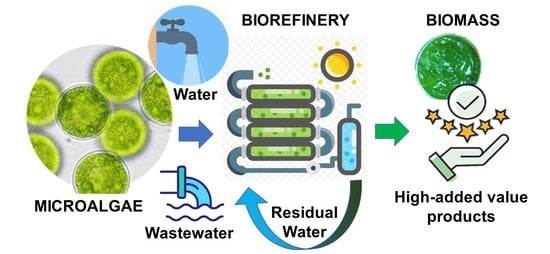Share and Cite
Olguín, E.J.; Sánchez-Galván, G.; Arias-Olguín, I.I.; Melo, F.J.; González-Portela, R.E.; Cruz, L.; De Philippis, R.; Adessi, A. Microalgae-Based Biorefineries: Challenges and Future Trends to Produce Carbohydrate Enriched Biomass, High-Added Value Products and Bioactive Compounds. Biology 2022, 11, 1146. https://doi.org/10.3390/biology11081146
Olguín EJ, Sánchez-Galván G, Arias-Olguín II, Melo FJ, González-Portela RE, Cruz L, De Philippis R, Adessi A. Microalgae-Based Biorefineries: Challenges and Future Trends to Produce Carbohydrate Enriched Biomass, High-Added Value Products and Bioactive Compounds. Biology. 2022; 11(8):1146. https://doi.org/10.3390/biology11081146
Chicago/Turabian StyleOlguín, Eugenia J., Gloria Sánchez-Galván, Imilla I. Arias-Olguín, Francisco J. Melo, Ricardo E. González-Portela, Lourdes Cruz, Roberto De Philippis, and Alessandra Adessi. 2022. "Microalgae-Based Biorefineries: Challenges and Future Trends to Produce Carbohydrate Enriched Biomass, High-Added Value Products and Bioactive Compounds" Biology 11, no. 8: 1146. https://doi.org/10.3390/biology11081146
APA StyleOlguín, E. J., Sánchez-Galván, G., Arias-Olguín, I. I., Melo, F. J., González-Portela, R. E., Cruz, L., De Philippis, R., & Adessi, A. (2022). Microalgae-Based Biorefineries: Challenges and Future Trends to Produce Carbohydrate Enriched Biomass, High-Added Value Products and Bioactive Compounds. Biology, 11(8), 1146. https://doi.org/10.3390/biology11081146









